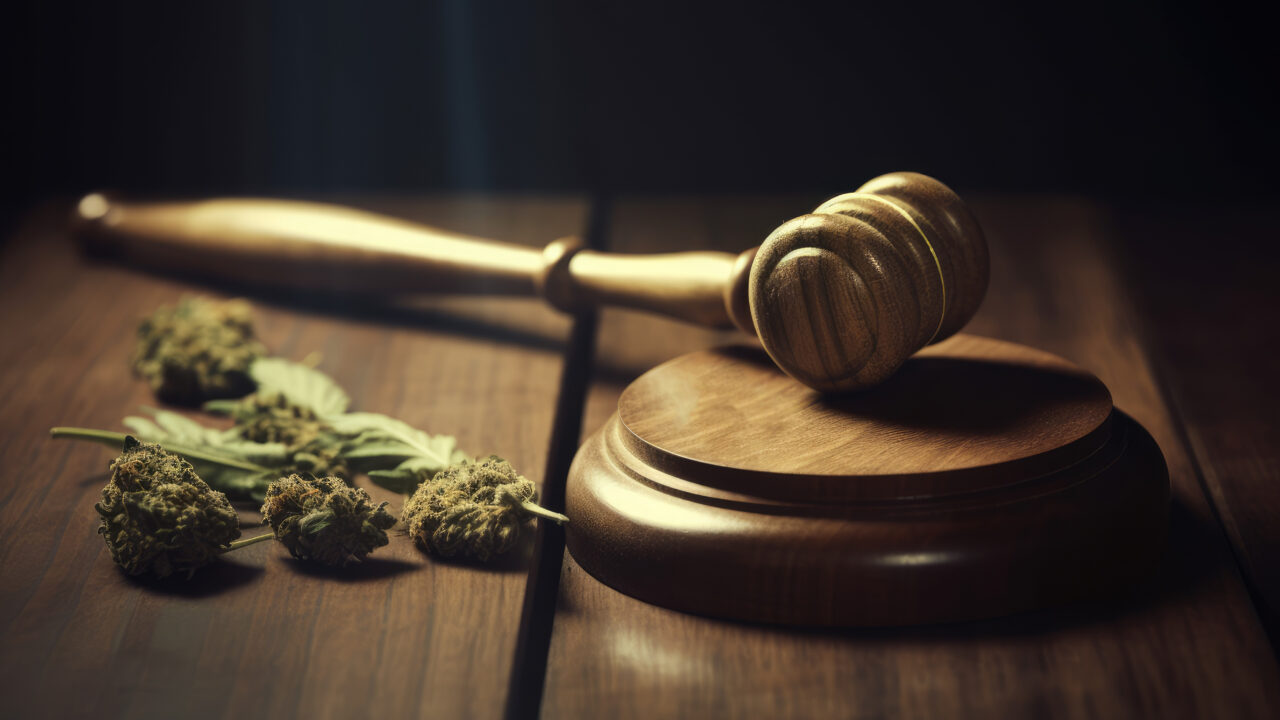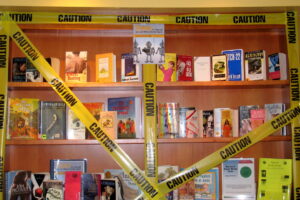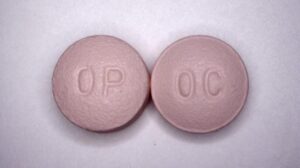The War on Weed Isn’t Over
In 2019, more than 500,000 Americans were arrested for cannabis-related charges, the vast majority for simple possession. Court gavel and marijuana side by side. (Photo: Adobe/cc)
Court gavel and marijuana side by side. (Photo: Adobe/cc)
The following excerpt is adapted from “Seeing through the Smoke: A Cannabis Specialist Untangles the Truth about Marijuana” by Peter Grinspoon, M.D., published on April 20 by Prometheus.
What have been the harms of criminalizing cannabis users? The damage, when added up, is staggering and includes about 20 million arrests in this country over the last fifty years. According to the ACLU, of the 8.2 million marijuana arrests between 2001 and 2010, 88%t were for simple possession of marijuana.
This has led to lifelong criminal records and in some cases imprisonment. It also resulted in vast amounts of collateral damage such as student loans denied, housing forfeited, voting rights revoked and families broken. The cycle of poverty created can last for generations, and it disproportionately affects communities of color.
An increasing awareness of these injustices, along with a pervasive yet growing sense that we’ve all been sold a bill of goods about cannabis by our government and many of our experts, combine to explain the astounding groundswell of public opinion in favor of legalization. As legalization spreads across the United States and across the globe, one might be tempted to think that arrests for simple cannabis possession have gone away. Unfortunately, that is not the case. In 2019, more than half a million Americans were arrested for cannabis-related charges, the vast majority of which (91.7 %), as usual, were for simple possession. In 2020, it was better, but there still were 350,000 arrests, with most of these arrests serving no purpose whatsoever. There shouldn’t be any arrests for simple cannabis possession. I believe that we should be focusing on expunging these harmful criminal records and on restitutions to people and communities that have been harmed, not on perpetuating greater harm.
Further, even though arrests are trending down, according to the paper “Racial Disparities in the Wake of Cannabis Legalization: Documenting Persistence and Change,” “substantial racial disparities persist following legalization.” A common saying is that the War on Drugs is nothing more than a war on (certain groups of) people. This is particularly true for the War on Cannabis.
The cycle of poverty created can last for generations, and it disproportionately affects communities of color.
According to integrative medicine pioneer and best-selling author Dr. Andrew Weil, “the ubiquity of drug use is so striking that it must represent a basic human appetite (The Natural Mind: An Investigation of Drugs and the Higher Consciousness (Boston: Houghton Mifflin, 1986).” Writer Michael Pollan echoes this thought when he cites the paucity of cultures and civilizations that have existed without the use of any psychoactive substances. The difference between heroin, which will promptly get you arrested, and codeine, morphine or oxycodone, which we frequently prescribe in clinics, is merely a few atoms. We freely accept the deadliest of drugs by the score — tobacco and alcohol, along with dozens of addictive, intoxicating prescription drugs — yet we have demonized much less dangerous drugs, including most psychedelic drugs, just because of their cultural or racial associations. Our drug control regime is incoherent and deadly.
Why are we waging war on cannabis users? Does this “war” fit any type of pattern?
In the book Drugs and Drug Policy: The Control of Consciousness Alteration, authors Clayton Mosher and Scott Akins discuss the demonization of illegal drugs and the “social construction of drug epidemics.” The main points they make are that:
- “The drug warrior industry, which includes both the private sector and a massive government bureaucracy devoted to ‘enforcement,’ has an enormous economic incentive to keep the war raging.” (This is part of why criminalization fit so well in the 1930s — alcohol prohibition had just ended, and there was a huge bureaucracy to support and justify.)
- “Government officials need drugs in order to create heroes and villains and, in many cases, to divert attention away from the issues which have caused the drug use in the first place.” (Such as homelessness, limited access to medical care, unemployment, racism and inequitable economic opportunity.)
Therefore,
“As a result of these needs . . . government and criminal justice officials in the United States, frequently assisted by the popular media, have engaged in a concerted campaign to demonize certain drugs in order to justify their prohibition (Clayton Mosher and Scott Akins, Drugs and Drug Policy: The Control of Consciousness Alteration, 2nd ed. (Los Angeles: SAGE, 2013) ”
According to Mosher and Akins, common techniques include blaming the commission of crime on these drugs (whether or not they actually are responsible); associating these drugs with bizarre or deviant actions such as uncontrollable sexual urges or violent acts (“voodoo pharmacology,” where the drug takes over); and, finally, asserting that the particular drug in question is “consumed primarily by members of underrepresented groups” and that the substances are “distributed primarily by evil foreign traffickers.”
Hmm . . . sound familiar?
Mosher and Akins go on to discuss several fluffed-up “epidemics” that fall into this pattern of governmental demonization. Every single aspect of it is true for cannabis, from blaming it on the Mexicans, to associating cannabis with sexually deviant and violent behavior, with the users at a complete loss to control themselves. As an example of this, in the movie “Reefer Madness,” people try to rape and shoot each other after using cannabis.
I will cite a 1967 quote from an official position piece in the Journal of the American Medical Association:
The use of marihuana among Puerto Ricans and both southern and northern Negroes is reputed to be quite high. In all likelihood, marihuana use among the poverty-stricken urbanite is concomitant with . . . a broad range of asocial and antisocial activity.
One could argue, fairly effortlessly, that the AMA were playing the part of “useful idiots” in laying the groundwork for Nixon’s upcoming War on Drugs.
As a cannabis user, it was easy to get arrested for cannabis, and I had many close calls. For example, next to the main lawn of Swarthmore College, I was enjoying a smoke with a few friends on a beautiful spring evening. Suddenly, out of nowhere, the fuzz appeared, sirens blaring. The officer physically cornered us with his squad car, jumped out, got right into our stoned faces and barked at us.
“Do you have any cigarettes in your pocket?”
“Um . . . no, officer, of course not. Smoking is bad for you.”
“Then what were you just smoking? Empty your pockets.”
I handed him my beautiful hand-carved wooden pipe and, sadly, my entire stash of high-end weed. One of my friends, a fellow philosophy major, started to argue with him about how morally bankrupt his entire position was and the ethical and racial abyss in which the officer was placing himself by accosting us. This wasn’t helping the prospects for getting us off the hook. Once we were able to shut my friend up and the officer could get a word in edgewise, he threatened to arrest us but instead settled for giving us a vicious tongue lashing.
How would being arrested for harmlessly and innocently smoking a little weed with friends on the Swarthmore College campus have helped anything? It is easy to come up with a long list of things it might have harmed. I doubt left-wing, Quaker-themed, drug-accepting Swarthmore would have kicked me out, but it would have precluded medical school, as admission committees don’t particularly approve of things like criminal records or drugs.
If I weren’t a middle-class white college student, I likely would have been arrested and charged — this infraction would have truly compromised all of my future prospects. Had we been arrested, we would likely have all dealt with something similar to the ordeal my friend and roommate went through a few years later. Brian was a successful consultant with the U.S. government who specialized in mitigating contaminants. We shared an apartment in Washington, D.C., during the time when I was working at Greenpeace’s national headquarters. Our apartment was right near the National Zoo, and when we hung out on our back porch on summer evenings, we would hear the lions roaring as well as many of the other animals. It sounded like we were on safari.
Brian was talented at brewing beer, but the only thing that truly quieted his constant anxious rumination was cannabis, which he would use at night. You could see a full-body unclenching with just one puff. Then he’d be happily socializing rather than just worrying neurotically about hypothetical problematical scenarios.
One afternoon, I was down at the Washington Mall with a friend — the same friend that gave the stoned sermon on morality to the cop at Swarthmore five years earlier. We were enjoying the splendid summer weather tossing a Frisbee when we received a panicked phone call: “This is Brian. I’ve been arrested for weed. This is my one call. They took my glasses, belt and shoelaces. I can’t see anything, and I’m sitting in a freezing cell with nothing to do. I’m going to lose my job. I’m freaking out. You have to bail me out.”
“Hang on, Brian, we’ll be there. This will be OK.”
What did he get arrested for? A nickel bag of pot, which is five dollars’ worth. It comes in a tiny bag and is probably about enough to consume in six modest puffs. It was late 1980s cannabis, with a lower THC content than today’s weed. It was barely enough to get one person high, once. He was buying it from a street dealer in Meridian Hill Park, which was right down the street from where we lived. He had no other source, as this was in the dark days before the advent of legal weed. Unbeknownst to him, the entire transaction was being watched by law enforcement, who materialized and pounced just after the deal was consummated. Brian said they had difficulty locating the five bag — and almost had to let him go — because they had him shoved up so hard against the police car that they couldn’t access the inner pocket he had hidden it in.
They threw the book at Brian because they were trying to move up the chain to implicate a drug dealer of some significance, which was bad luck and bad news for Brian.
If I weren’t a middle-class white college student, I likely would have been arrested and charged — this infraction would have truly compromised all of my future prospects.
Brian’s plight was as good as you could get for a cannabis arrest. It was in D.C., not in Georgia or Alabama, where the laws were draconian, leading to years in prison. Most importantly, and unfairly, he was a white professional whom the criminal justice system would greatly favor if he acted a certain way, choreographed by his expensive attorney. Being a professional, he could afford a specialized attorney (whom my dad hooked him up with). With all of these advantages, he still suffered from several years of immense anxiety over this, thousands in legal fees, repeated court appearances, mandatory drug testing and lots of uncertainty. He was barely able to hang on to his job and had to contend with this blemish on his record. He didn’t have cannabis to help him relax anymore, so he started drinking much more heavily. It is mind-boggling that he went through all of this grief and punishment — and that our society wasted all of these resources — for the crime of self-treating his anxiety with a tiny bag of weak cannabis.
Black people have had it far worse. They use cannabis at the same rate as whites do, yet they are arrested at almost four times the rate of white people. The smell of cannabis is considered “probable cause” in many states, particularly in southern states, and this allows the policeperson to snoop around and look for things to bust them for. Blacks are much more likely to end up in prison for the same infractions and to suffer far more severe consequences from the same criminal records. This impacts jobs, finances, housing and education. Families are broken up.
It is no wonder that, at my twin brother’s wedding, when my older brother and I snuck outside with some family friends to smoke a joint, they were much more concerned about concealment than we were. I was totally insensitive. We were in a slightly darkened alleyway, and I said, “We can just smoke here; no one will care.” One friend gave me a pointed look and said, “Not if you look like us.” We found a much more secluded place to spark up.
I doubt Brian would still be working for the government if he had dark skin, and he may well have ended up behind bars. In 1989, there were 400,000 other cannabis arrests in the United States, all equally as useless and destructive.
Peter Grinspoon, M.D., is the author, most recently, of “Seeing through the Smoke: A Cannabis Specialist Untangles the Truth about Marijuana.” He is a primary care physician and cannabis specialist at Massachusetts General Hospital and an instructor in medicine at Harvard Medical School.
Your support is crucial...As we navigate an uncertain 2025, with a new administration questioning press freedoms, the risks are clear: our ability to report freely is under threat.
Your tax-deductible donation enables us to dig deeper, delivering fearless investigative reporting and analysis that exposes the reality beneath the headlines — without compromise.
Now is the time to take action. Stand with our courageous journalists. Donate today to protect a free press, uphold democracy and uncover the stories that need to be told.







You need to be a supporter to comment.
There are currently no responses to this article.
Be the first to respond.